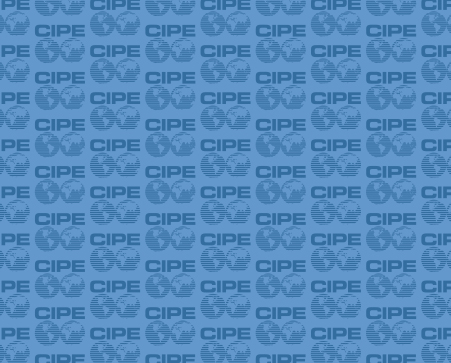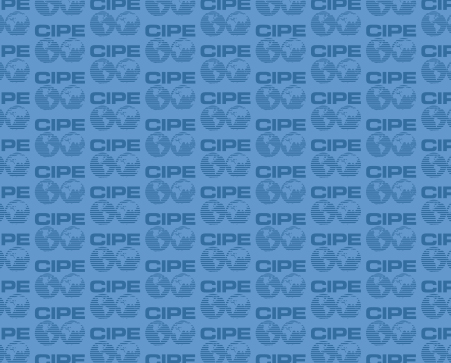
Sustainable Development Goal 5 set the bar to “achieve gender equality and empower all women and girls” by 2030. Closing gender gaps in work and society could add $12 trillion to global GDP by 2025, according to McKinsey Global Institute. This figure underscores the socioeconomic importance as well as global economic potential available if we achieve gender parity, the theme of this year’s International Women’s Day Forum led by the United Nations and U.S. Chamber of Commerce Foundation.
The Forum is an annual, collective effort to convene government, private sector, and civil society and “put on our gender glasses” as one participant descriptively put it. Humbly, many stakeholders – both public and private – admitted this year that the data necessary to establish a baseline to then track our advancement towards this goal of gender parity remains either poor or non-existent. Examining both global value chains and individual business models through a gender lens allows for a foundation of knowledge that helps provide a clear understanding of how strategies and operations are influencing women’s empowerment.
Among the many conversations taking place during what should more aptly be named International Women’s Month, I found the dialogue around gender integration into business model and value chains particularly exciting. Encouragingly, more and more businesses are realizing that social impact and business profit do not always occur at the expense of one another. Not every company may aspire to be a social enterprise, but every company can become more gender inclusive by integrating women in product design, manufacturing, production, sales, and distribution channels within its value chain. In fact those that are integrating gender are, in turn, becoming more competitive. Companies from SMEs to multinationals can now tap into these social and economic impacts by adapting these lessons learned in the following areas into their own business models and value chains.
Equitable systems, structures, and policies
Last year, Acumen partnered with the Cartier Foundation and the International Center for Research on Women (ICRW) to examine how its investees were including or excluding women in their business models, recognizing the gap in Acumen’s own data on the topic. The findings of the report, Women and Social Enterprises: How Gender Integration Can Boost Entrepreneurial Solutions to Poverty, uncovered both concerted as well as more happenstance efforts to integrate women within the business model.
In a panel at the Acumen 2015 Partner Gathering, Yasmina Zaidman of Acumen, CEO of Acumen investee from Peru, Wasi Organics Marta del Rio, CEO of Labournet Gayathri Vasudevan, and Acumen Board member Pat Mitchell discussed the innovative ways Acumen portfolio companies were dually integrating women and seeing both social and economic dividends. Del Rio shared her company’s targeted approach to gender integration stating she “needed talent desperately and couldn’t pay for it as a start-up, [in order to recruit high skilled women] I needed to look at asymmetries in the market. [These] asymmetries were where you have a lot of talent unable to get a proper job because [most women] cannot work standard hours. Very few companies in Peru are forward thinking enough to notice that, and realize that [a flexible work schedule] is an amazing resource.” By offering women what other companies couldn’t – flexibility – Wasi Organics gained an appreciative, loyal, and competitive workforce.
In addition to organizational structure, businesses can leverage their codes of ethics or conduct and policies in influencing the communities they operate in as well as across their value chains. By strictly enforcing gender-inclusive supplier codes and policies, multinational companies can encourage the small to mid-sized firms they partner with to put similar policies in place. Gulu Agricultural Development Company (GADC) is exemplary in taking a proactive and gender-sensitive approach that recognizes the high level of domestic violence where it works in Uganda. Keeping its code of conduct alive with orientation training each farming season, GADC is creating an environment with zero tolerance for sexual harassment that in turn yields greater productivity.
Product design
At another recent conversation exploring private sector and gender equality at the Center for Global Development (CGD), Senior Fellow and Co-Director of CGD’s Gender and Development Program Mayra Buvinic pointed out that for both goods and services, interventions have mainly focused on the demand side – increasing women’s access to products, as opposed to the supply side of thoughtfully considering and customizing products based on women’s needs and desires. One prime example is financial services, which many institutions still assume are gender neutral, failing to account for the lack of proper identification, loan collateral, or mobility that keeps women from accessing financial services.
One example of a company working innovatively with gender is GUARDIAN (Gramalaya Urban and Rural Development Initiatives and Network) in South India, which offers a unique sanitation group loan scheme aimed at female clients, allowing them to join with their neighbors and share both the risk and benefits instead of taking these on individually. Female clients appreciated that little documentation was required to obtain the loan, while low interest rates compared to other financial institutions put less strain on their limited capital and monthly income. Furthermore, doorstep collection and monthly installments created flexibility – neighbors could also cover a payment if necessary.
By taking the day-to-day realities of women living at the bottom of the pyramid into close consideration, both buyer and seller benefit. More broadly, by supporting and encouraging young girls, who have a better understanding of the challenges, into fields like financial services and engineering, society can benefit from better products and services.

Production and manufacturing
Achieving gender parity also means engaging women in non-traditional ways – namely, encouraging women into jobs traditionally reserved for men. Debunking stereotypes that women are unable to handle heavy lifting or operating machinery as part of male-dominated sectors like manufacturing is crucial because these sectors are often also higher paying.
BURN, an Acumen investee that manufactures, markets, and sells energy-efficient cookstoves in East Africa, is among several clean cookstove companies yet one of the unique few that manufactures locally. Clean cookstoves offer a healthier, more economical alternative to traditional wood or charcoal cookstoves that consume more fuel and emit carbon monoxide and other toxic fumes – most directly affecting the young women who cook with them. Employing more than 100 people in its factory – half of whom are women – BURN undercuts the belief that women can’t work in manufacturing. Providing on-the-job training, BURN gives workers with little prior experience or technical knowledge an entry point into the job market.
This is especially powerful for Kenya which, according to the United Nations’ Economic Commission for Africa, has the highest level of informal sector employment among its peers. “Three out of four workers are employed in the informal sector, a proportion that increases to over 80 percent among women,” cites the report. What’s more, BURN frequently promotes factory line workers to sales agent positions, which “enables women who may not have originally had adequate sales skills to become experts in the Jikokoa [cookstove], advance within the company, and become effective sales agents who are able to effectively reach female customers.”
Integrating women into manufacturing and production teams is a great initial entry point from which they can move up – being promoted through the ranks of marketing sales positions to even the managerial level, learning each step of the way. One woman mentioned in the report began her career path as an intern and continued rising into the roles of line producer, machine operator, and now line manager.
More broadly, equal employment influences a cultural mindset shift that recognizes equal capabilities across gender. In some cases, such as agricultural production, men reflected that working with women was in fact more advantageous as they tended to pay closer attention to details, which contributed to higher performance.
Marketing, sales, and distribution
Forbes estimates women drive 70-80 percent of all consumer purchasing. Because women largely control consumer purchasing, companies are wise to hire more women for their marketing and sales teams. In order to reach its intended customers, companies can gain from a woman’s perspective on what messaging resonates with them, and in a developing country context, where and how to advertise a good or service given limited mobility due to household responsibilities and travel restrictions. Companies will also likely find that satisfying one female customer often results in a multiplier effect with customer referrals among neighbors and friends in her community. In the example of BURN’s Jikokoa or “saving stove,” a shift to using a clean cookstove can translate into a household saving valuable time and up to $250 a year, as the stove cuts fuel consumption by 56 percent – thus reducing carbon emissions and indoor air pollution, and decreasing the rate of deforestation.
By employing a diverse sales team, GUARDIAN utilizes the strengths of both female and male loan officers. While female credit officers can more easily initiate first contact with female customers, who tend to feel more secure inviting female loan officers into their home, male loan officers can approach sometimes apprehensive husbands as well as provide support if clients refuse to pay. Together, male and female officers learn from one another’s strengths and challenges. The report noted that “female credit officers reported experiencing increased confidence, autonomy, and agency in engaging and communicating with both female and male customers and managing difficult situations.” Externally, the report found that when women engaged in non-traditional roles typically reserved for men, the community’s perception of women’s capacity changed.
Women’s increased ownership along a value chain ignites a ripple effect of increased purchasing power, economic empowerment, and for companies, an expanded market. By continuing to raise and address one of the greatest social problems of our time – gender inclusion – companies will benefit from more people moving into the markets for their products. Gender parity means so much more than the empowerment of women alone, it is about unleashing the full potential on an entire society so that everyone can fully thrive.
Read the full report by Acumen, the Cartier Foundation, and the International Center for Research on Women, watch the conversation from the 2015 Acumen Partner Gathering, and watch the panel discussion from the Center for Global Development.
Stephanie Bandyk is a Program Assistant for Global Programs at CIPE.
Published Date: March 11, 2016